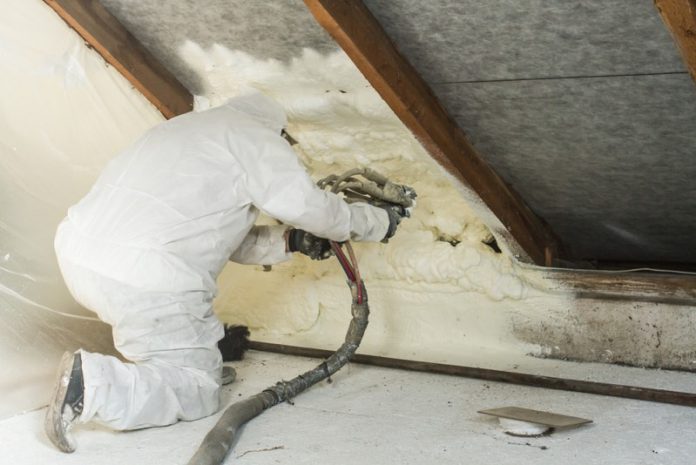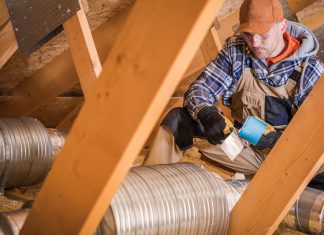Modern building technologies are reinventing the materials used to build homes to ensure efficiency and reduced costs. There are many factors to consider when choosing a construction technology and with the issue of global warming becoming so dire, environmental sustainability and costs have become some of the most popular factors for builders.
In roof spray foam installations, we examine spray foams as an ideal secondary alternative to traditional roofing technologies. The spray foam is coated on top of a primary roof to provide further insulation against the elements.
Most home roofing also suffers from nail fatigue and where the zoning restrictions prevent a complete overhaul of the primary roofing to provide for insulation or secondary roofing layers. Insulation is a very important feature in modern buildings and spray Foam roofs are fast becoming the most popular alternatives to perennially available materials such as rubber, metal, gravel, or EPS.
What are roof spray foams?
Spray foam roofing is a new roofing technology that incorporates three materials technologies namely:
- Polyurethane foam
- Silicone coating, and
- Granules
Most roofing consists of saturated areas that need repair, and the polyurethane foam, forms from the mixture of two different chemicals, polyol/resin & isocyanate, which are poured in from two different containers to a mixed spray gun. The combination of these two chemicals occurs in a high-temperature environment and therefore specialized clothing is required during installation.
The thin layer of foam increases in size 30x and depending on the type of primary roofing in place, the installer can level the foam at the required height. About 20-25 MLS of silicone coating is then applied on top of the polyurethane foam to protect it from direct sunlight. This silicone coating is applied in two layers, with the top layer covered in granules to increase strength and increase traction/friction.
Things to consider before installing a spray foam roof.
The type of primary roof dictates the method of spray foam installation. For example, if the roof has gravel, then the stones have to first be removed to expose the underlying surface. Afterward, adhesive and fasteners are used to ensure the roofing layer sticks to the insulation. Thereafter, the spray foam is installed. However, if the roof has a primary rubber coating, the installer merely has to clean it properly and then install the spray foam directly.
The height of the building is also a primary factor to consider before installing a spray foam roof. Low-storied buildings are the cheapest especially if there is good access to the roof.
The weather conditions factor a lot when it comes to installing spray foam roofs. The best weather for installation is warm and dry weather. High temperatures ensure the chemicals bond properly and the adhesive factor is higher than in cooler temperatures. Since the foam is sprayed, the conditions have to be less windy as windy conditions will prevent even application of the foam leading to some areas getting more foam than others.
Finally, ensure you get a qualified and licensed installer. Finding the right contractor could mean the difference between a well-installed roof and one that requires constant maintenance. The Spray Polyurethane Foam Alliance (SPFA) keeps a constantly updated database of contractors who are licensed and qualified to apply a spray foam roof.
Advantages of Spray foam roof installations
Spray foam roofs have many advantages over other types of secondary roof installations. These advantages are:
1. Better insulating power
One of the biggest factors to consider when choosing a roof installation is the way the roof handles heat variations. Polyurethane has a very high R-value, whereby R is the capacity of a material to resist the flow of heat. The importance of these features cannot be overstated especially with global warming causing the destruction of underlying housing structures made of poorer R materials. Overall, a high R-value leads to an increasing reduction in cooling and heating costs.
2. Easy installation
Spray foam roofs are very easy to install as compared to the other materials because they are spray applied and therefore can go around obstacles quite easily. Furthermore, as part of installations, the spray foam covers defects caused by wear and tear, and this protective cover, adds an extra layer of protection against the elements thereby extending the shelf life of the underlying roofing material.
3. Seamless roofing installation
Unlike other types of roofing installations such as boards or rubber, the spray roofing is seamless as it does not consist of added parts. The spray forms one main coating over the entire roof and this reduces risks of leaks. The closed-cell nature of the spray foam ensures it does not leak water in case of rainfall. The material is non-absorbent and therefore you can expect water to simply stay in one place in the event there is a depression in the area to cause water to pool in one area.
Ensure you have a maintenance contract or arrangement with your installer. Spray foam roofs tend to be quite susceptible to impacts such as hailstones, and excessive sandstorms. In the event of any such occurrences, your roof will probably require repairs. In most cases, the installer will offer subsidies on costs of maintenance, but if you prefer a different contractor to conduct the repairs, then expect higher costs. Your initial contractors will probably have warranties and subsidies from their materials supplier and therefore you should ask for this as a prerequisite before settling on any one contractor.
Overall, spray foam roofs offer a lot of versatility, and with the high-temperature variances; you should choose an option that keeps your indoor temperature standard. The roofs also look aesthetically pleasing, and the rough gravel provides sufficient traction in case of roof repairs or simply choosing to walk on the roof. The surface remains reliable even in extreme weather and with sufficient maintenance; you can expect a roof to last up to twenty years without requiring a heavy overhaul.
Adequate maintenance will also bump up the houses’ location making it fetch more in resale value.















